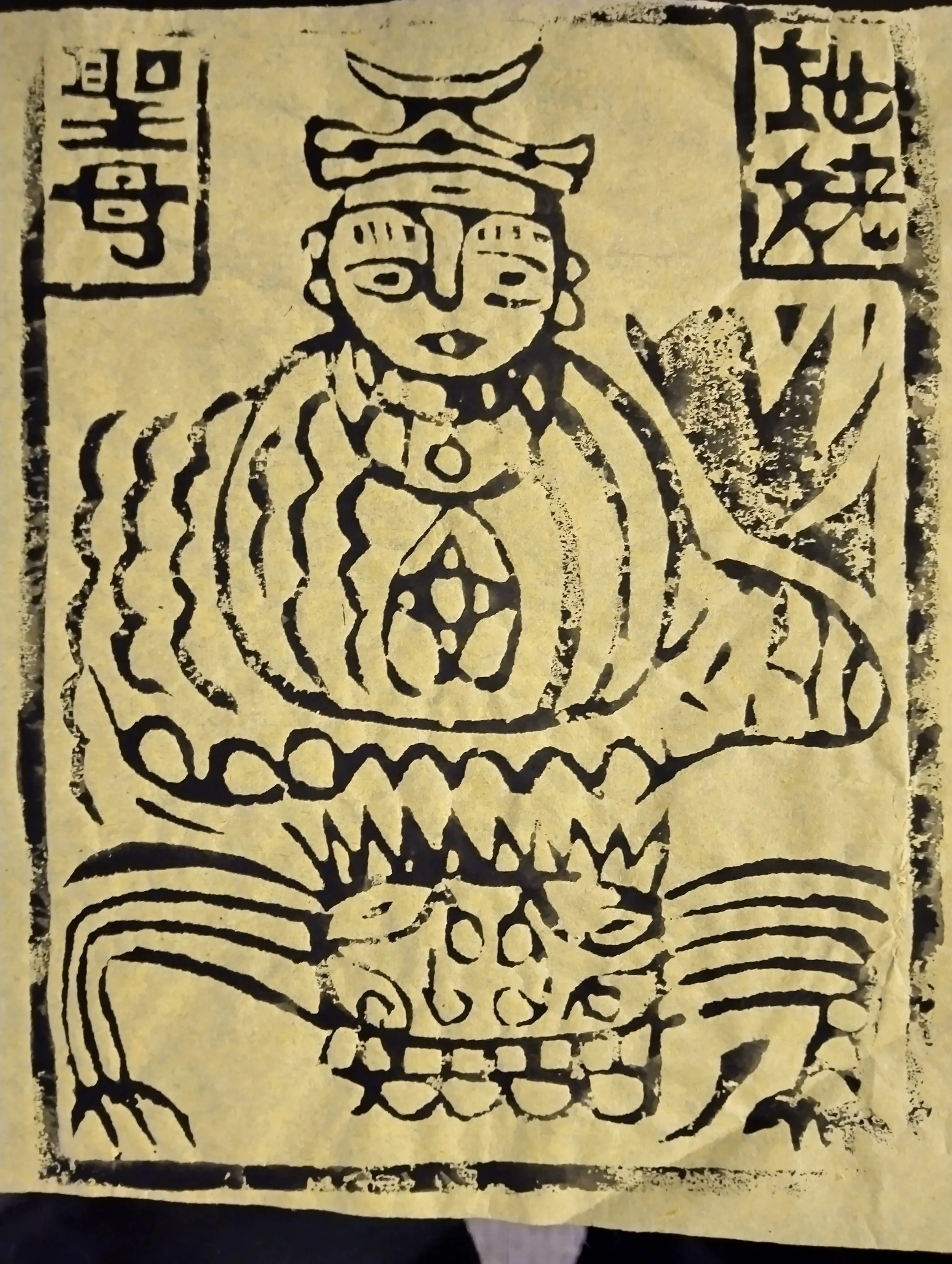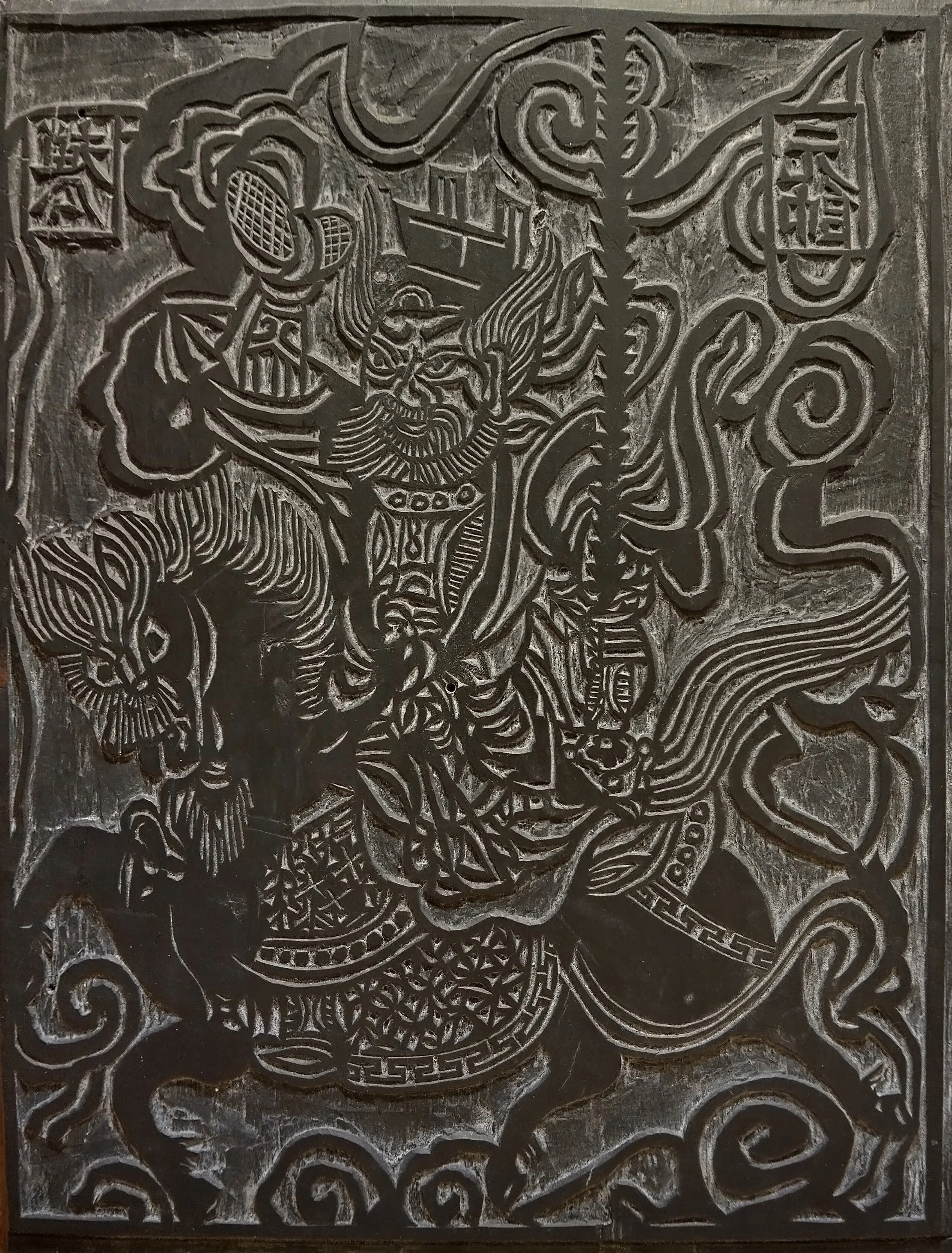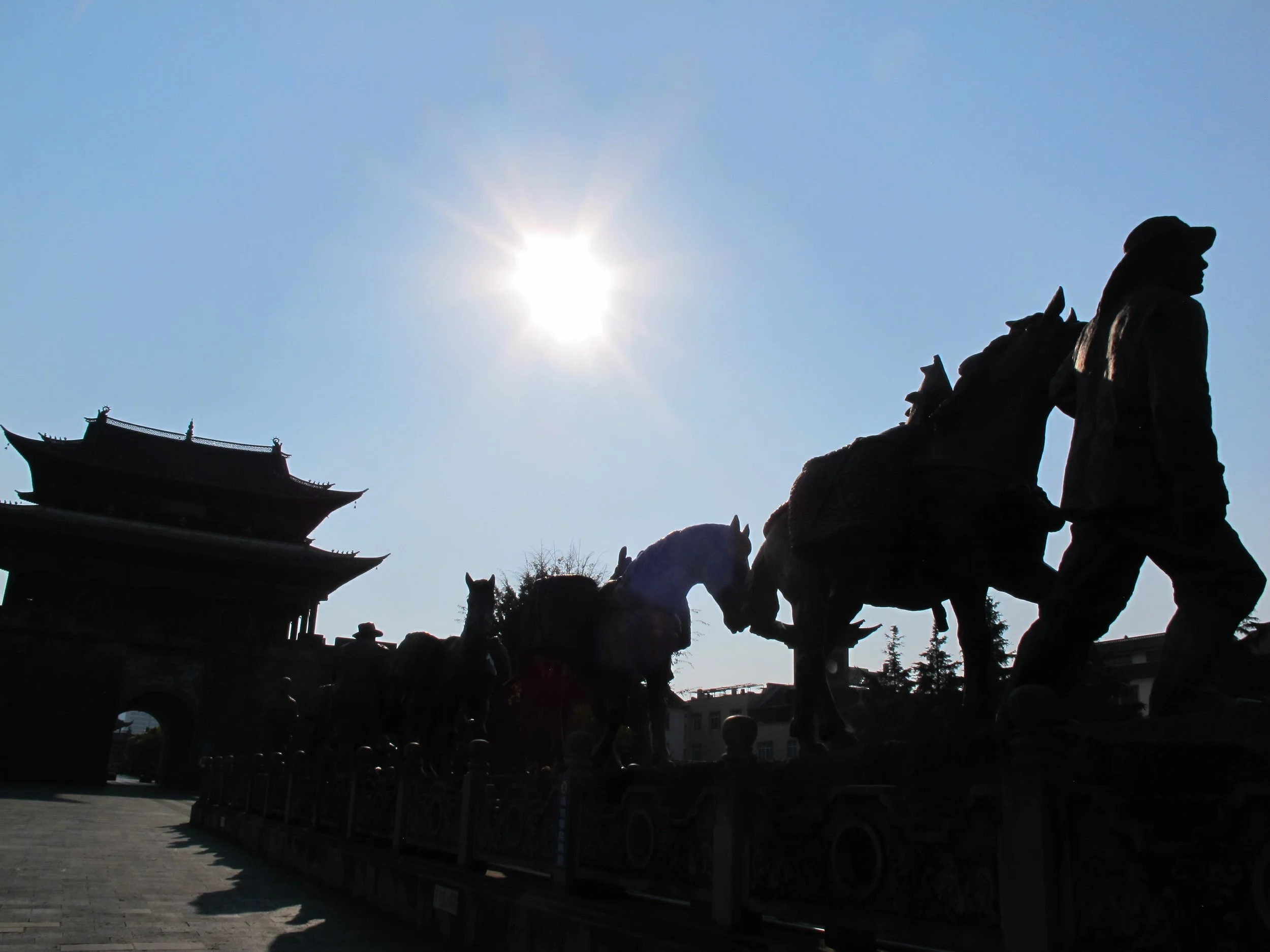Bai Woodblocks from Yunnan
Zhima sold as single sheets or bound together on sticks like flags. Included in each bundle are Wenchang, Patron of Literature (文昌); pairs in pink and green asking for increasing profits, wealth and sons (利市仙官 and 抬财童子); the gods of roads and bridges (桥路二神) and mountains and places (山神土地); and wishes for a peaceful year (四季平安).
Mrs Wang chatted away as I bought a handful of small folk prints of local deities outside the Pigsy temple in Xizhuang: “They’re part of the old beliefs, benzhu, we use them at funerals and all sorts of festivals”.
Benzhu (本主, “original lords of the land”) is the folk religion of the Bai people, who are spread between Dali and Baoshan in western Yunnan province. Mountain ranges either side make this area something of a north-south corridor between the foothills of Tibet and borders with Burma, Laos and Vietnam. Before the thirteenth-century Yuan invasions China’s influence here was very slight, and the region was ruled by the Nanzhao and Dali kingdoms, the latter of which stretched south into modern Thailand.
Migrations up and down the corridor have left it awash with ethnic groups including the Bai, Lisu, Yi, Han Chinese and Tibetans. Benzhu practices have absorbed elements of these different cultures’ beliefs, alongside more mainstream Daoism, Buddhism and Confucianism. Some deities are immediately recognisable as members of the Chinese pantheon, some are given a local twist, and a few appear very alien indeed.
Small deity folk prints are widely known as zhima (纸马), “paper horses”; the Yunnan accent makes this sound like jiama (甲马), “armoured horses”. They can be burned, included as offerings in sacrificial ceremonies, or pasted up – I’ve seen them on houses, buses and taxis – but their purpose is always the same: to attract blessings and ward off disasters.
Zhima of the twin deities of harmony pasted up inside a bus, presumably so passengers don’t haggle over their fare or pick fights with each other
So here are some recently collected zhima prints and blocks. The woodblocks come from an antiques dealer in Kunming, the prints from the Pigsy temple at Xizhuang village, Baoshan (保山西庄猪八戒寺).
Red Wealth God 紅財神
Red Wealth comes from Tibetan Buddhism, where he’s known as Red Jambhala (Dzambhala Marpo) and appears with multiple faces and limbs, disporting with his consort Vasudhara. Here the tigers are a nod to the Chinese military god of wealth, who is usually shown riding one.
Benzhu Da Wang Erwang 本主大王二王
The story goes that one of the rulers of the Nanzhao Kingdom at Dali (AD738–902) was overthrown and fled south with two loyal bodyguards to the Baoshan area. They eventually hid out at Xizhuang village, where the former king became a monk until his death several years later.
Meanwhile his son managed to win back the Nanzhao Kingdom and went looking for the old king. After a long search, he found that his father had died at Xizhuang, served to the end by his two bodyguards. The prince rewarded their loyalty with high titles and official positions at Dali, but they had married local women and had no wish to leave Xizhuang.
The two came to be known as “The Older King and Younger King”, and after their deaths villagers built a shrine to them at Xizhuang’s Pigsy temple, which includes statues of their wives (named Jiang and Chen).
The two loyal bodyguards shown here as officials wearing brown and green robes. One wife sits inbetween them, the other is obscured by the near pillar
Zhenwu 真武大帝
The Great Emperor Zhenwu (真武大帝; his name means “True Warrior”) is a martial deity, also god of the north. He’s usually seen with his feet supressing a turtle and a snake, representing his ability to prevent flooding; some regional prints just show the animals without the deity. Text at the bottom (鎮宅光明) suggests this print is to protect the home; couplets either side read “Sweeps Away a Thousand Disasters; Ushers in a Hundred Blessings” (掃去千災 ; 迎來百福).
Three zhima designs on the back of the Zhenwu block, possibly test prints (if the intent was to cut them into this side of the block and use it for printing too – a common way to save on costs – the prints should have been pasted on face down). The left-hand one is to protect cattle; the other two nameplates can’t be read and the designs are too general to guess the deities shown
Our Lady of the Earth 地姥聖母
I can find no information about this exact deity – she might well be local to Xizhuang – but it’s likely to be a version of Houtu (后土), the supreme head of all Earth gods (土地公), deities who protect the inhabitants and land of every place in China.
Marshal Zhao 趙公元帥
Unusual block showing the military god of wealth Zhao Gongming holding his normal cudgel and gold ingot, but riding a horse instead of a black tiger. The design is from the town of Heshun, outside Tengchong (腾冲和顺), right down in Yunnan’s far southwestern corner.
Statue of a mule train at Tengchong, just a few kilometres from Heshun
Despite its small size Heshun grew wealthy during the early nineteenth century from its position on the main trade route between Yunnan and Burma, its merchants dealing in jade, gems and cotton. Mule trains, sometimes numbering hundreds of animals and weighed down with valuable goods, passed through town almost all year round, polishing the flagstoned bridges nearby to almost mirror smoothness – so it’s not surprising to find the local version of the god of wealth depicted on horseback.
Zhao Gongming is an extremely popular deity across the region, with his statue in almost every temple; he drives away storms, plagues and disasters as well as bringing in profits. His prints are burned or displayed during weddings, festivals, construction projects and setting up new businesses, but must not be used outside – which would amount to asking wealth to leave the premises.
Thanks to Jarek
Sources
Feng Jicai Collection of Chinese New Year Woodblock Prints – Yunnan Jiama Volume (中国木版年画集成 – 云南甲马卷; Zhonghua Shuju 2007)
Fitzgerald, C.P. The Tower of Five Glories (Cresset Press 1941)
The actor who played Zhu Bajie in the 1986 version of Journey to the West visited the Bajie Temple in Xizhuang, Banqiao Town (86版西游记猪八戒扮演者到访板桥镇西庄八戒寺; weixin.qq.com; 2023)
Yang Haolin The Paper-Charms of Bai Nation (杨浩林:古老神秘的白族甲马; Yunnan Minzu Chubanshe 2013)









